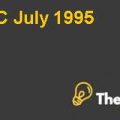Mountain Man Brewing Company: Bringing the Brand to Light Case Study Solution
The younger population spent twice as much per capita on alcoholic products as compared to the population over 35 years of age and is expected to grow in near future.(Sheetz, 2019). The social factors affecting the brewery industry includes; the preference of younger generation for low-alcoholic beers, spirits based drinks and wines. Also, the low or no alcohol beers category is growing on account of the fact that people get aware of the adverse and serious health concerns the alcohol intake posit on their health(Arthur, 2019). The technological factors affecting the industry includes: the automation at every stage of process of brewing could allow the company to lead the market.
The craft brewers of America continue to lead towards the global craft beer movement in terms of development of new flavors and innovation that steer away from traditional styles (Norman, 2016). The brewers need to comply with redundant rules at the state level, franchise laws that restrict their ability directly sell their products to customers, and such rule could dictate the way through which brewers’ contract with distributors(Koopman, 2014). Moreover, the market players are making enormous amount of investment in energy efficient technologies, because the majority of the American beer consumers stated that they prefer to pay more for sustainably reduced products due to which the market players are required to invest in equipment to conserve energy or water or use solar panels to limit the greenhouse emission(COHEN, 2018).The model can be seen in Appendix B.
The bargaining power of buyer is of high force because of existence of many market players offering high quality products at low prices. Also, the cost of switching from MMBC to another company is relatively low for buyers and many similar tasting light beer are available in market. The bargaining power of suppliers is low force because of wide availability of suppliers in market, homogenous supply ingredients and stable prices of supplies.
The threat of substitute product is high force because many light beer are available on shelf, and the buyer could easily switch to low-alcoholic, energy drinks, spirits or wine, keeping in mind the rising health concerns. The threat of new entrant is low force, because the market is highly concentrated and the entry is only feasible at small scale i.e. microbrewery. Other entry barriers includes’ high capital, extensive knowledge and experience, create and maintain brand loyalty and presence of leading brands in the market.The intensity of rivalry is high force because of differentiated featured light beer products provided by market rivals, also the brand loyalty is also strong. The model can be seen in Appendix C........................................
This is just a sample partical work. Please place the order on the website to get your own originally done case solution.












